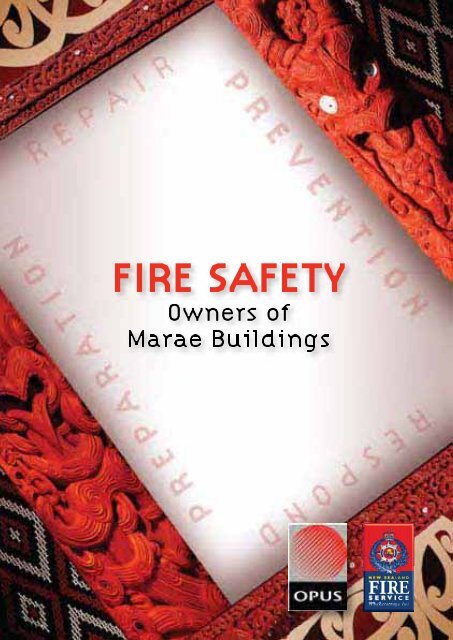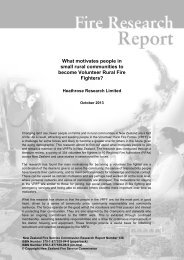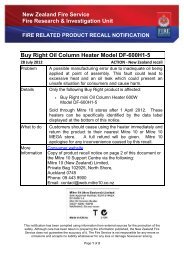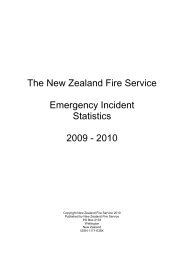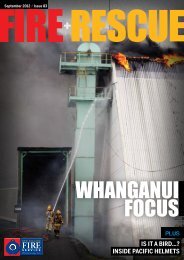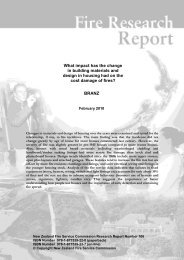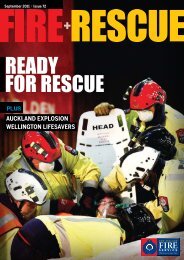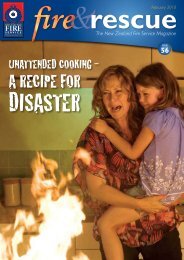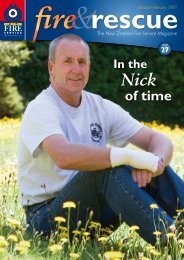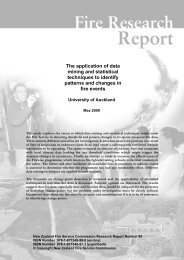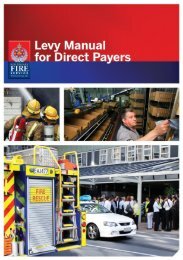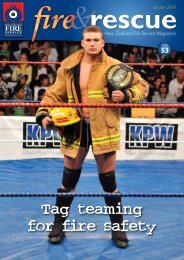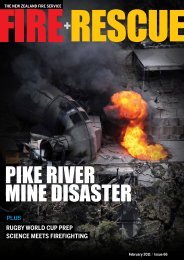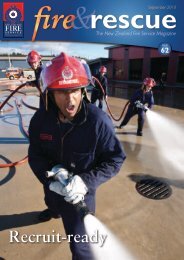Fire Safety - Owners of Marae Buildings - New Zealand Fire Service
Fire Safety - Owners of Marae Buildings - New Zealand Fire Service
Fire Safety - Owners of Marae Buildings - New Zealand Fire Service
Create successful ePaper yourself
Turn your PDF publications into a flip-book with our unique Google optimized e-Paper software.
FIRE SAFETY
CONTENTS<br />
Introduction 3<br />
Prevention 4<br />
Plan and Train 4<br />
Management 4<br />
Governance 4<br />
Heritage Management Standards 5<br />
Maintenance Plans 5<br />
Off-site Security 6<br />
Building Works and Special Events 6<br />
<strong>Fire</strong> Evacuation Procedures 6<br />
Training 7<br />
Preparation 8<br />
The <strong>Fire</strong> <strong>Safety</strong> Plan 8<br />
Significance Assessment 8<br />
Conservation Plans 9<br />
Description <strong>of</strong> Building 10<br />
Taonga 10<br />
Conservation Risks 11<br />
Preventive Conservation 12<br />
<strong>Fire</strong> Risk Assessment 12<br />
Likelihood 13<br />
Consequences 13<br />
Action Plan 14<br />
Funding 15<br />
Cost-effective Protection Systems 15<br />
Smoke Detectors 16<br />
Sprinkler Standards 17<br />
Training Plan 18<br />
Response Team 18<br />
Develop a List <strong>of</strong> Emergency Contacts 18<br />
Support Networks 19<br />
Disaster Bins 19<br />
Respond 20<br />
<strong>Fire</strong> Response Plan 20<br />
General Evacuation Procedures 20<br />
Steps in Effective Response to a <strong>Fire</strong> 21<br />
Recover 22<br />
Recovery Plan 22<br />
Conclusion 24<br />
Checklist 24
INTRODUCTION<br />
This Information Booklet outlines the basic procedures<br />
for <strong>Marae</strong> Committees and Trustees to use when thinking<br />
about and planning for a fire on their <strong>Marae</strong>.<br />
It is based on Guidelines for Managing <strong>Fire</strong> Risks in Historic<br />
<strong>Buildings</strong> and Heritage Collections, which may be downloaded<br />
from the <strong>New</strong> <strong>Zealand</strong> <strong>Fire</strong> <strong>Service</strong>s web site –<br />
www.fire.org.nz/research/reports/index_num.htm<br />
The Guidelines outline the steps to be followed to prepare a<br />
<strong>Fire</strong> <strong>Safety</strong> Plan. The steps are based on the four following criteria:<br />
Prevention<br />
Preparation<br />
Response<br />
Recovery.<br />
The principles <strong>of</strong> fire safety in <strong>Marae</strong> buildings are to:<br />
<br />
<br />
<br />
<br />
<br />
Prevent fires from starting<br />
Safeguard life<br />
Detect, restrict and extinguish any fire<br />
Minimise damage to the fabric <strong>of</strong> the building<br />
Protects <strong>New</strong> <strong>Zealand</strong>’s iconic cultural buildings<br />
and their contents.<br />
3
4<br />
PREVENTION<br />
Plan and Train<br />
The main elements <strong>of</strong> fire prevention are to plan for it by:<br />
<br />
<br />
Having good management systems in place that have:<br />
identified the risks<br />
taken actions to prevent them<br />
prepared for a fire occurring<br />
Training people to prevent, prepare, respond and<br />
recover from a fire.<br />
Management<br />
Good management is the key to identifying and<br />
preventing fires in marae.<br />
Governance<br />
Good management systems depend on good governance structures<br />
being in place, so arrangements for governing the marae may need<br />
to be improved before effective management <strong>of</strong> fire risk can begin.<br />
Te Papa National <strong>Service</strong>s have prepared the <strong>New</strong> <strong>Zealand</strong> Museums<br />
Standards Scheme and Museum Resource Guides, which are very<br />
helpful for people and organisations requiring advice about all<br />
aspects <strong>of</strong> museum management. The principles may be applied<br />
to the management <strong>of</strong> marae. Formal arrangements include such<br />
things as:<br />
<br />
<br />
<br />
<br />
<br />
<br />
A Statement <strong>of</strong> Purpose<br />
Terms <strong>of</strong> reference for committee/board members<br />
Acknowledgement <strong>of</strong> the Treaty <strong>of</strong> Waitangi and the mana<br />
<strong>of</strong> tangata whenua<br />
Formal adherence to a code <strong>of</strong> ethics<br />
Nomination process<br />
Iwi representation
Statement <strong>of</strong> decision-making process and meeting cycle<br />
Committee/board members procedures manual<br />
Access to specialist advice including Ma-<br />
ori Consultation.<br />
Te Papa’s governance information is based on the resource<br />
guide: Getting on Board: a Governance Resource Guide for Arts<br />
Organisations, prepared by Creative <strong>New</strong> <strong>Zealand</strong>, which may<br />
be downloaded as a PDF file from http://www.creativenz.govt.nz<br />
/resources/publications.html.<br />
Another website with helpful information is<br />
www.tpk.govt.governance.<br />
Heritage Management Standards<br />
The management <strong>of</strong> fire safety in historic buildings is different<br />
from the management <strong>of</strong> other places because they are special<br />
and irreplaceable places that should be looked after according to<br />
“best-practice” heritage management standards.<br />
Maintenance Plans<br />
Regular maintenance <strong>of</strong> a building, particularly a heritage building,<br />
is the single most important conservation measure. It is important<br />
that all marae have some form <strong>of</strong> regular Maintenance Plan.<br />
The <strong>Fire</strong> <strong>Safety</strong> Plan should be incorporated into the marae<br />
maintenance schedule.<br />
Those preventive actions that have been identified in the Action<br />
Plan, (see page 14) and prioritised, e.g. installation <strong>of</strong> sprinklers,<br />
security systems, etc., should be incorporated into the regular<br />
maintenance schedule so that the preventive actions are not<br />
overlooked, are budgeted for, and are included in other work to<br />
save costs e.g – if the ro<strong>of</strong> is to be lifted and repaired it may be<br />
a good time to install sprinklers.<br />
5
6<br />
Off-site Security<br />
It is essential to keep duplicate copies <strong>of</strong> important documentation<br />
<strong>of</strong>f-site because these will be required if there is a fire and may not<br />
otherwise be accessible.<br />
Important documents that should be kept in another place include:<br />
Insurance policies<br />
Building description/layout<br />
Back-up files <strong>of</strong> records <strong>of</strong> collection<br />
Negatives and/or duplicate copies <strong>of</strong> photographs etc.<br />
<strong>Fire</strong> <strong>Safety</strong> Plan – has sections on response and recovery,<br />
which will be needed but may not be accessible if there is<br />
a fire in the building.<br />
Building Works and Special Events<br />
Events outside the normal daily activities <strong>of</strong> the building require<br />
careful planning.<br />
During construction or renovation, which are high-risk times for<br />
fires to occur, workmen may use inappropriate, or unsafe equipment<br />
if they do not know the risks to the building and collection.<br />
A “hot-work” procedure needs to be implemented to ensure that<br />
fires do not arise or are discovered as early as possible.<br />
It is important to have straightforward practices in place to train<br />
people who are not familiar with the building, but who may be<br />
occupying it during special events, to ensure their protection and<br />
the safety <strong>of</strong> the building and or collection.<br />
<strong>Fire</strong> Evacuation Procedures<br />
Develop a “Flipchart” to quickly remind people <strong>of</strong> the emergency<br />
procedures to follow in the event <strong>of</strong> a fire (and other disasters)<br />
and the evacuation procedures. This gives the things to do for<br />
specific emergencies including fires.
Training<br />
Training everyone in fire safety prevention and response is the<br />
second major aspect <strong>of</strong> fire prevention.<br />
EVERYONE must be very familiar with the <strong>Fire</strong> <strong>Safety</strong> Plan.<br />
They should understand the importance <strong>of</strong> day-to-day preventive<br />
actions such as:<br />
good housekeeping: removal <strong>of</strong> rubbish, tidiness, cleanliness,<br />
regular maintenance<br />
daily fire safety checks: turning <strong>of</strong>f appliances, security checks<br />
the role each person plays in keeping the marae safe from fire<br />
Develop ways to effectively inform visitors during special events<br />
about fire safety in the building.<br />
Effective training is the essence <strong>of</strong> any plan succeeding and the<br />
procedures must be practised to ensure that the plan works and to<br />
make certain that everybody understands their role if a fire occurs.<br />
7
8<br />
PREPARATION<br />
The <strong>Fire</strong> <strong>Safety</strong> Plan<br />
The <strong>Fire</strong> <strong>Safety</strong> Plan includes the actions to take to prevent or<br />
reduce the effects <strong>of</strong> a fire, emergency procedures, and how<br />
to respond and recover from a fire.<br />
The <strong>Fire</strong> <strong>Safety</strong> Plan is a living document, so it should be regularly<br />
reviewed and altered as things change or new information is obtained.<br />
It is subdivided into smaller plans or documents covering specific<br />
areas or steps in fire safety management. These sub-plans may be<br />
used separately and include:<br />
<br />
<br />
<br />
<br />
<br />
<br />
<br />
<br />
Significance Assessment<br />
<strong>Fire</strong> Risk Assessment<br />
<strong>Fire</strong> Risk Index<br />
Action Plan<br />
Training Plan<br />
<strong>Fire</strong> Response Plan<br />
Flip Chart<br />
Recovery Plan.<br />
Significance Assessment<br />
Once the decision to prepare a <strong>Fire</strong> <strong>Safety</strong> Plan has been made<br />
the first action is to undertake an assessment <strong>of</strong> the significance<br />
<strong>of</strong> the marae buildings and their contents so that the risks can<br />
then be worked out within a conservation context.<br />
The significance criteria for buildings, places, objects and collections<br />
include the historic, aesthetic, scientific, technical, cultural, spiritual,<br />
traditional and social values that the item has for past, present and<br />
future generations. A place or item need not possess all the criteria<br />
to be highly significant.
Conservation Plans<br />
It is recommended that a Conservation Plan be prepared<br />
for marae buildings <strong>of</strong> high significance as part <strong>of</strong> the<br />
“best practice” management.<br />
This should be commissioned before any changes to the<br />
building and will guide any work or alterations to the fabric<br />
<strong>of</strong> the building that may be required to improve its fire safety.<br />
It will include specialist advice from conservation architects,<br />
heritage consultants and engineers including fire engineers.<br />
For information about funding for conservation plans and other<br />
conservation and building works on marae, see the Department<br />
<strong>of</strong> Internal Affairs website http://www.dia.govt.nz/diawebsite.<br />
NSF/wpg_URL/<strong>Service</strong>s-Lottery-Grants-<strong>Marae</strong>-Heritageand-Facilities?OpenDocument<br />
For all heritage buildings, including buildings <strong>of</strong> less significance,<br />
it is important to seek the advice <strong>of</strong> architects and fire engineers<br />
pr<strong>of</strong>icient in the conservation <strong>of</strong> heritage buildings. The same<br />
applies to builders and contractors – those who have experience<br />
with heritage buildings and an understanding <strong>of</strong> conservation<br />
requirements are more likely to produce results which are good<br />
for heritage than are those accustomed to working solely on<br />
new or recent buildings.<br />
9
10<br />
Description <strong>of</strong> Building<br />
A description <strong>of</strong> the building is required for the<br />
Significance Assessment. This will be used later in<br />
the <strong>Fire</strong> Risk Assessment and the <strong>Fire</strong> Response Plan.<br />
It is useful for the local <strong>Fire</strong> <strong>Service</strong> to have this plan<br />
and information about the building in their records in<br />
the event <strong>of</strong> a fire.<br />
The description will include:<br />
<br />
<br />
<br />
<br />
<br />
<br />
General layout <strong>of</strong> the buildings, and its setting,<br />
e.g. wharenui, dining room, kitchen, access<br />
Floor plan, e.g. main room, toilets, mezzanine<br />
Use <strong>of</strong> building e.g. hui, sleeping<br />
Construction and materials <strong>of</strong> building e.g. wood,<br />
corrugated iron ro<strong>of</strong><br />
Significant fabric e.g. carvings, maihi<br />
Contents <strong>of</strong> building e.g. painted rafters,<br />
photographs, artefacts.<br />
Taonga<br />
Many marae also contain heritage collections and have<br />
significant fabric e.g. carvings, that are both part <strong>of</strong> the building<br />
and part <strong>of</strong> the “collection.” A list <strong>of</strong> the all the heritage objects<br />
should be made. From this list another list should be made <strong>of</strong> the<br />
most important items in the building. It is important that this list<br />
is written with everyone’s agreement otherwise difficulties may<br />
occur when the objects are being salvaged. Remember to keep<br />
copies <strong>of</strong> photographs etc. <strong>of</strong>f-site.
Conservation Risks<br />
Although this guideline is concerned with risks to buildings and<br />
collections from fire, all <strong>of</strong> the ten categories <strong>of</strong> risk to a collection<br />
will need to be considered in the Recovery Plan because the effects<br />
<strong>of</strong> the fire and water will change the environment <strong>of</strong> the marae<br />
buildings, which can also be damaged by these risks.<br />
They are:<br />
<br />
<br />
<br />
<br />
<br />
<br />
<br />
<br />
<br />
<br />
Physical forces: e.g. breakage, distortion, abrasion<br />
<strong>Fire</strong>: e.g. complete destruction, scorching, soot, smoke<br />
and water damage<br />
Water dissolution: e.g. tide marks, efflorescence,<br />
warping, shrinking<br />
Criminals: e.g. arson, theft, vandalism, tagging<br />
Pests: e.g. holes, chewing, soiling<br />
Contaminants: e.g. staining, disintegration, organic vapours.<br />
Light and UV Radiation: e.g. fading, yellowing,<br />
structural damage<br />
Incorrect temperature: e.g. melting, embrittlement, fracture<br />
Incorrect relative humidity: e.g. mould, swelling,<br />
dehydration, fracture<br />
Dissociation: e.g. inaccessibility, irretrievability, loss <strong>of</strong><br />
objects, loss <strong>of</strong> object data.<br />
11
12<br />
Preventive Conservation<br />
Preventive conservation is the practice <strong>of</strong> looking after the objects<br />
in your care. It is achieved by:<br />
Controlling the environment in your building<br />
Careful handling and displaying <strong>of</strong> items<br />
Good storage and security, pest control and planning<br />
for emergencies.<br />
A building in public ownership that has a heritage collection<br />
should follow best-practice management systems. Te Papa<br />
National <strong>Service</strong>s have produced a number <strong>of</strong> Resource Guides<br />
to aid museums and other organisations to care for their<br />
collections appropriately. The guides include one on preventive<br />
conservation. The address is http://www.tepapa.govt.nz/<br />
tepapa/english/nationalservices/resourceguides/<br />
he+Rauemi+resource+guides.html<br />
<strong>Fire</strong> Risk Assessment<br />
The <strong>New</strong> <strong>Zealand</strong> <strong>Fire</strong> <strong>Service</strong>, and the <strong>New</strong> <strong>Zealand</strong> Historic Places<br />
Trust provide free specialist advice to help with fire risk assessments<br />
on marae. This booklet will use a simple method <strong>of</strong> rating fire risks<br />
according to the probability <strong>of</strong> a fire and its estimated impact to<br />
enable the completion <strong>of</strong> a fire risk assessment to be undertaken by<br />
marae committees and trustees. This can be used to raise awareness<br />
<strong>of</strong> fire risks in the marae and the need for preventive actions and<br />
specialist advice.<br />
When undertaking a fire risk assessment it is necessary to first<br />
review all the past fires in the building because this will identify<br />
areas <strong>of</strong> risk that may need to be addressed and helps in deciding<br />
the probability <strong>of</strong> a fire, and then to identify all the types <strong>of</strong> risks<br />
to the building including external risks, risks posed by the building<br />
itself and its contents, the risks during building or maintenance<br />
and the risk <strong>of</strong> arson.<br />
Use the checklist described on page 24 to help do this.
Likelihood<br />
The probability <strong>of</strong> a fire occurring can be estimated by using<br />
the historical information collected combined with common<br />
sense and knowledge <strong>of</strong> the building and community.<br />
It is helpful to consult the local <strong>Fire</strong> <strong>Service</strong> for their views<br />
on the risks to the building and collection.<br />
This will also enable the <strong>Fire</strong> <strong>Service</strong> to understand the specific<br />
needs <strong>of</strong> the heritage building.<br />
Consequences<br />
Identify the level <strong>of</strong> potential threat to the building and collection<br />
by giving each checkpoint on the Checklist (page 24) a score <strong>of</strong><br />
either high, medium, low. There are two checklists to be made:<br />
one for the collection and one for the building.<br />
Mark the risk to your collection on the list <strong>of</strong> significant taonga.<br />
The checklist <strong>of</strong> potential risks is measuring several things: e.g<br />
<br />
<br />
<br />
The risk <strong>of</strong> a fire happening e.g. from gas fired portable heaters<br />
The lack <strong>of</strong> actions or procedures in place to minimise the risk<br />
e.g. no fire alarms or sprinklers<br />
The impact <strong>of</strong> the loss e.g. loss <strong>of</strong> nationally significant building.<br />
The list <strong>of</strong> taonga is measuring the heritage loss if the particular<br />
object is damaged or destroyed.<br />
13
14<br />
Action Plan<br />
Once the risks to the marae and taonga have been identified it<br />
is necessary to develop an Action Plan that will reduce or remove<br />
the risks.<br />
Those risks that fall into the high category in the risk analysis<br />
should receive the highest priority when it comes to developing<br />
actions and allocating time and money to implement them.<br />
The Action Plan will include all preventive actions identified from the<br />
risk assessments and (if relevant) included in the Conservation Plan.<br />
These should be transferred into the building’s maintenance schedule.<br />
They may include improvements to:<br />
<br />
<br />
<br />
<br />
<br />
<strong>Fire</strong> safety systems: fire alarm and fire detection systems,<br />
emergency lighting and signs, communications, lightning<br />
protection, testing and maintenance <strong>of</strong> fire safety systems,<br />
emergency shut-<strong>of</strong>f controls<br />
<strong>Fire</strong> fighting supplies: water supplies, hose reels and portable<br />
fire extinguishers, generators<br />
Means <strong>of</strong> escape: designated escape routes, doors and openings<br />
Compartmentation <strong>of</strong> the building and structural fire protection:<br />
including improved storage facilities for taonga and mattresses<br />
<strong>Fire</strong> service access: liaison with the <strong>Fire</strong> <strong>Service</strong>.<br />
It is important to have a logbook to record all the actions undertaken,<br />
including training plans and any problems as they occur and the<br />
solutions to the problems. This logbook will identify areas <strong>of</strong> weakness<br />
or potential disasters as well as providing a record <strong>of</strong> the management<br />
<strong>of</strong> fire safety in the building.
The Action Plan will also include fire prevention practices:<br />
Good house keeping practices: storage <strong>of</strong> combustible<br />
materials, removal <strong>of</strong> rubbish, vegetation and fuel sources,<br />
cleanliness, regular maintenance <strong>of</strong> alarms and appliances,<br />
outside hoses connected to taps<br />
<strong>Fire</strong> security checklists: daily/weekly/monthly/annual<br />
Procedures for “hot work” when maintaining or renovating<br />
building: e.g. “Hot-work” plan, methods <strong>of</strong> supervision to be<br />
used (e.g. a fire extinguisher close by), daily inspections after<br />
potentially hazardous activities.<br />
A helpful website about fire prevention is http://www.fire.org.nz/<br />
home_kids/homesafe/questions.htm<br />
Funding<br />
For information about sources <strong>of</strong> funding from the Department<br />
<strong>of</strong> Internal Affairs Lotteries Grants see http://www.dia.govt.nz/<br />
diawebsite.NSF/wpg_URL/<strong>Service</strong>s-Lottery-Grants-<br />
Environment-and-Heritage?OpenDocument<br />
For information about how do find out about funding sources<br />
and seeking sponsorship see http://www.tepapa.govt.nz/<br />
TePapa/English/National<strong>Service</strong>s/ResourceGuides/He+Rauemi+<br />
Resource+Guides.htm<br />
<br />
<br />
Tapping into Funding Sources (issue No 2)<br />
Making Sponsorship Work for You (issue No 15).<br />
Cost-effective Protection Systems<br />
Major improvements to life safety and property protection can<br />
be achieved for very modest costs by installing smoke detectors<br />
and sprinklers.<br />
15
16<br />
Smoke Detectors<br />
Stand-alone battery operated smoke alarms complete with<br />
hush buttons are inexpensive, although hard-wired alarm<br />
systems are preferable, to avoid the need for continual<br />
battery changing.<br />
Hard-wired alarms can be connected to an intruder alarm<br />
system if fitted, and remotely monitored by a security company,<br />
although there will be an ongoing monitoring cost.<br />
A system complying with the <strong>New</strong> <strong>Zealand</strong> standards is best,<br />
providing the opportunity to directly connect the alarm system<br />
to the <strong>Fire</strong> <strong>Service</strong>, but this will be the most expensive option.<br />
Any suitable, well-maintained system is far superior to no<br />
system at all.
Sprinkler Standards<br />
There are three sprinkler standards in <strong>New</strong> <strong>Zealand</strong><br />
NZS 4541 covers the majority <strong>of</strong> <strong>New</strong> <strong>Zealand</strong>’s commercial<br />
and industrial buildings.<br />
2 NZS 4515 covers smaller buildings <strong>of</strong> less than 2,000m and<br />
less than four storeys, primarily residential occupancies, small<br />
apartment buildings, rest homes etc. These standards require<br />
the sprinkler system to have its own independent water<br />
supply, and a sprinkler valve set to control activation. As highly<br />
engineered systems, they are relatively expensive.<br />
NZS 4517 - <strong>Fire</strong> Sprinkler Systems for Houses, was introduced<br />
to allow for lower cost sprinkler coverage in domestic<br />
residential dwellings.<br />
In its simplest form, a sprinkler system complying with NZS 4517 will<br />
not provide early warning <strong>of</strong> fire, and it is essential that smoke alarms<br />
are installed.<br />
The intention <strong>of</strong> NZS 4517 is to provide significantly improved safety<br />
for the occupants and a reasonable degree <strong>of</strong> property protection<br />
at modest cost. The standard allows the sprinkler system to be an<br />
extension <strong>of</strong> the domestic plumbing system and to be installed by a<br />
plumber.<br />
Compliance with the standard requires protection in living rooms,<br />
kitchens, bedrooms, hallways and attached garages because these<br />
places are where most fires start, but protection is option all in<br />
ro<strong>of</strong> spaces, underfloor spaces, basements, cupboards, porches and<br />
detached garages or outbuildings.<br />
The provision <strong>of</strong> a water flow alarm connected to the <strong>Fire</strong> <strong>Service</strong> or<br />
a private security company is also optional. The water can be from a<br />
reticulated supply, a pumped supply from a tank, stream or pond, an<br />
elevated tank or a gas pressurised storage tank.<br />
For storage systems, the tank capacity is modest as the design flows<br />
are small, and must be maintained for a minimum <strong>of</strong> only 10 minutes.<br />
17
18<br />
Training Plan<br />
A training plan identifies what training<br />
is required and when it is going to take<br />
place. The training programme should be<br />
integrated into the overall management<br />
strategy <strong>of</strong> the marae.<br />
<br />
<br />
<br />
<br />
<br />
Run training workshops on preventive behaviour<br />
Run training workshops on evacuation procedures<br />
Schedule regular workshops and training days to up-date<br />
people on the <strong>Fire</strong> <strong>Safety</strong> Plan<br />
Practise fire drills regularly<br />
Organise specialist workshops with the <strong>Fire</strong> <strong>Service</strong>.<br />
Response Team<br />
It is essential to establish a <strong>Fire</strong> Response team. Decide who will<br />
be part <strong>of</strong> team and what their roles will be; match the people<br />
with the jobs and make sure everyone knows what their job is<br />
and what to do. These people can be listed on a Telephone Tree,<br />
e.g. the <strong>Fire</strong> Co-ordinator is telephoned first and he/she rings the<br />
next people who ring the people on their list.<br />
Develop a List <strong>of</strong> Emergency Contacts<br />
Prepare a list <strong>of</strong> contacts with telephone numbers and make<br />
sure everybody knows where it is. This will include <strong>Fire</strong> Brigade and<br />
telephone number as well as people on Telephone Tree.
Support Networks<br />
It is helpful to develop support networks and contacts because<br />
these will be critical if there is a fire.<br />
<br />
<br />
Contact specific expertise e.g.<br />
<strong>New</strong> <strong>Zealand</strong> Historic Places Trust Staff:<br />
www.historic.org.nz<br />
<strong>New</strong> <strong>Zealand</strong> <strong>Fire</strong> <strong>Service</strong>:<br />
www.fire.org.nz<br />
Te Papa National <strong>Service</strong>s:<br />
www.tepapa.govt.nz/TePapa/English/National<strong>Service</strong>s<br />
<strong>New</strong> <strong>Zealand</strong> Pr<strong>of</strong>essional Conservators Group:<br />
www.conservators.org.nz<br />
Develop a register <strong>of</strong> volunteers.<br />
Disaster Bins<br />
Disaster recovery supplies are a key element to any plan. These are<br />
useful materials, which have been set aside especially for an emergency<br />
and are only used for such events. They include: buckets, mops, dust<br />
pan and broom, first aid kit, scissors, tape, a disposable camera, pencils,<br />
and salvage procedures sheets. They may be stored in a “wheely” bin,<br />
cupboard or box.<br />
19
20<br />
RESPOND<br />
<strong>Fire</strong> Response Plan<br />
The <strong>Fire</strong> Response Plan is used when a fire threatens, during or<br />
immediately after a fire has occurred. It should be able to guide<br />
people through the initial responses and first critical actions.<br />
It covers all the actions that will occur until the point when the<br />
Recovery Plan is prepared.<br />
The main points about responding effectively to a fire are:<br />
<br />
<br />
<br />
<br />
<br />
<br />
<br />
<br />
<br />
<br />
Human safety overrides everything – KNOW the<br />
Evacuation procedures<br />
Try to control the source <strong>of</strong> the problem<br />
Know who to call immediately<br />
Know how to assess the site<br />
Know the building layout especially where the Disaster Bin is<br />
Know the collection priorities – where they are and how to<br />
retrieve them<br />
Know how to stabilise the situation<br />
Be able to assess the situation and any damage<br />
Have areas already identified into which damaged<br />
objects can be moved<br />
Know whom to call for help, e.g. conservation pr<strong>of</strong>essionals etc.<br />
General Evacuation Procedures<br />
Remain calm<br />
Turn <strong>of</strong>f all hazardous operations<br />
Follow instructions<br />
Assist disabled people<br />
Leave the area in an orderly fashion<br />
Follow the established evacuation route
Move away from the building. Go directly to the assembly area<br />
and report to the Evacuation Co-ordinator for a ‘head count’<br />
Do not block the street, driveway or building entrances<br />
Stay in the assembly area until instructed otherwise.<br />
For useful information, see http://www.fire.org.nz/home_kids/<br />
homesafe/whattodo.htm<br />
Steps in Effective Response to a <strong>Fire</strong><br />
Activate the <strong>Fire</strong> Alarm<br />
Follow the Emergency Response Procedure<br />
Evacuate visitors and staff<br />
Retrieve Priority List Objects if possible<br />
Call <strong>Fire</strong> Co-ordinator if relevant<br />
Work through <strong>Safety</strong> Checklist to determine site stability<br />
Ensure there is no source <strong>of</strong> ongoing damage<br />
(turn <strong>of</strong>f water, cover shelves etc.)<br />
Stabilise the situation as much as possible<br />
(turn <strong>of</strong>f utilities, open windows)<br />
Use the contents <strong>of</strong> the Disaster Bin to deal with any<br />
immediate problems<br />
Assess the damage and the situation to determine the extent<br />
<strong>of</strong> the disaster<br />
Use the Assess and Stabilise checklist<br />
Document all damage<br />
Activate the Telephone Tree and call the rest <strong>of</strong> the <strong>Fire</strong> team<br />
if required<br />
Go through the Response Plan to check if you have<br />
forgotten anything<br />
Sit down, review the situation, and use the Recovery Plan<br />
to plan the recovery.<br />
21
22<br />
RECOVER<br />
Recovery Plan<br />
Prepare a Recovery Plan to be used once you have responded<br />
and dealt with the immediate issues (using the Response Plan)<br />
and have time to stop and consider how the building is going<br />
to get back to normal.<br />
The main objectives are to:<br />
<br />
<br />
<br />
<br />
<br />
<br />
Ensure the safety <strong>of</strong> all those in the building<br />
Reduce the damage to the collection and building<br />
(this will also reduce costs)<br />
Record the damage for insurance and record keeping purposes<br />
Stabilise the environment<br />
Save as much <strong>of</strong> the collection and building as possible<br />
Return to normal activities as soon as possible.
24<br />
CONCLUSION<br />
Once the building has returned to normal it is essential that<br />
you have a debriefing session to evaluate how effectively<br />
the <strong>Fire</strong> <strong>Safety</strong> Plan has worked and what improvements<br />
should be made to ensure that in the event <strong>of</strong> another fire<br />
every thing has been prepared for.<br />
It must be remembered that the <strong>Fire</strong> <strong>Safety</strong> Plan is not a static<br />
document, but a plan to be used, evaluated and modified as<br />
knowledge and circumstances change.<br />
The <strong>Fire</strong> <strong>Safety</strong> Plan is a useful tool for ensuring that bestpractice<br />
conservation standards are integrated into managing<br />
the prevention <strong>of</strong> fires in marae.<br />
For more information about writing a <strong>Fire</strong> <strong>Safety</strong> Plan or for<br />
more information about things mentioned in this booklet refer<br />
to Guidelines for Managing <strong>Fire</strong> Risks in Historic <strong>Buildings</strong> and<br />
Heritage Collections.<br />
Checklist<br />
A checklist to use when evaluating the fire risks to your museum<br />
and the building it is housed in is attached to the Guidelines for<br />
Managing <strong>Fire</strong> Risks in Historic <strong>Buildings</strong> and Heritage Collections<br />
which is available on the <strong>New</strong> <strong>Zealand</strong> <strong>Fire</strong> <strong>Service</strong>’s website<br />
www.fire.org.nz/research/reports/index_num.htm
For further information please contact<br />
maori@fire.org.nz or 0800 MAHUIKA


